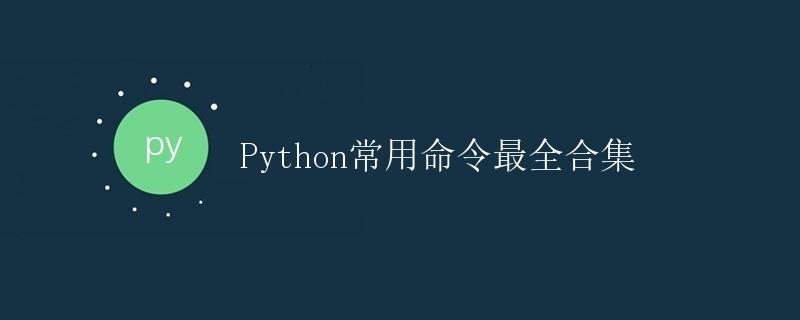Python常用命令最全合集

1. 引言
Python是一种高级编程语言,广泛应用于多个领域,如Web开发、数据科学、人工智能等。在 Python 的开发过程中,我们经常需要使用一些常用命令来完成各种任务,比如查看变量类型、创建数据结构、控制流程等。本文将详细介绍 Python 常用命令的使用方法和示例代码。
2. 变量与数据类型
在 Python 中,可以使用以下命令来定义变量和使用不同的数据类型:
=: 赋值运算符,用于给变量赋值。type(): 返回变量的类型。str(),int(),float(),bool(): 类型转换函数,用于将变量转换为字符串、整数、浮点数和布尔值。input(): 用于接收用户输入。
# 定义变量并赋值
name = "Alice"
age = 25
height = 1.75
is_student = True
# 打印变量类型
print(type(name)) # <class 'str'>
print(type(age)) # <class 'int'>
print(type(height)) # <class 'float'>
print(type(is_student))# <class 'bool'>
# 类型转换
age_str = str(age)
height_int = int(height)
is_student_str = str(is_student)
is_student_bool = bool(is_student_str)
# 接收用户输入并打印
user_input = input("请输入您的姓名:")
print("您输入的姓名是:" + user_input)
3. 控制流程
Python 提供了多种控制流程语句,用于根据条件执行不同的代码块。下面是常用的控制流程命令:
if-else: 用于根据条件执行不同的代码块。for-in: 用于遍历可迭代对象中的元素。while: 用于循环执行代码块,直到条件不满足为止。break: 用于跳出循环。continue: 用于跳过当前迭代,进入下一次迭代。
# if-else
age = 18
if age >= 18:
print("您已成年")
else:
print("您未成年")
# for-in
fruits = ["apple", "banana", "cherry"]
for fruit in fruits:
print(fruit)
# while
count = 0
while count < 5:
print(count)
count += 1
# break
for i in range(10):
if i == 5:
break
print(i)
# continue
for i in range(10):
if i % 2 == 0:
continue
print(i)
4. 字符串操作
Python 中的字符串是不可变的,可以使用以下命令来进行操作:
+: 用于字符串拼接。len(): 返回字符串的长度。lower(),upper(): 将字符串转换为小写或大写。strip(): 去除字符串两端的空格。split(): 将字符串拆分成列表。join(): 将列表中的字符串连接起来成为一个新的字符串。replace(): 替换字符串中的某个子串。find(),index(): 查找字符串中某个子串的位置。
# 字符串拼接
name = "Alice"
age = 25
greeting = "Hello, " + name + "! You are " + str(age) + " years old."
print(greeting)
# 字符串长度
greeting_length = len(greeting)
print("The length of greeting is", greeting_length)
# 大小写转换
greeting_lower = greeting.lower()
greeting_upper = greeting.upper()
print("Lowercase:", greeting_lower)
print("Uppercase:", greeting_upper)
# 去除空格
text = " Python is easy to learn. "
stripped_text = text.strip()
print(stripped_text)
# 字符串拆分
words = text.split()
print(words)
# 列表连接
combined_text = "-".join(words)
print(combined_text)
# 字符串替换
replaced_text = text.replace("Python", "Java")
print(replaced_text)
# 查找子串
index = text.find("easy")
print("The index of 'easy' is", index)
index = text.index("easy")
print("The index of 'easy' is", index)
5. 列表和元组
列表和元组是 Python 中常用的数据结构,可以使用以下命令对它们进行操作:
[]: 用于创建列表。len(): 返回列表或元组的长度。append(): 在列表末尾添加元素。insert(): 在列表的指定位置插入元素。remove(): 移除列表中第一个匹配的元素。pop(): 移除列表中的元素,并返回该元素的值。index(): 返回列表中第一个出现指定元素的索引。count(): 返回列表中指定元素的出现次数。sort(): 对列表进行排序。
# 创建列表和元组
fruits = ["apple", "banana", "cherry"]
colors = ("red", "green", "blue")
# 访问元素和长度
print(fruits[0]) # apple
print(colors[1]) # green
print(len(fruits)) # 3
print(len(colors)) # 3
# 添加元素
fruits.append("orange")
print(fruits) # ["apple", "banana", "cherry", "orange"]
# 插入元素
fruits.insert(1, "grape")
print(fruits) # ["apple", "grape", "banana", "cherry", "orange"]
# 移除元素
fruits.remove("banana")
print(fruits) # ["apple", "grape", "cherry", "orange"]
# 弹出元素
popped_fruit = fruits.pop()
print(popped_fruit) # orange
print(fruits) # ["apple", "grape", "cherry"]
# 查找元素
index = fruits.index("grape")
print("The index of 'grape' is", index)
# 元素计数
count = fruits.count("apple")
print("The count of 'apple' is", count)
# 列表排序
fruits.sort()
print(fruits) # ["apple", "cherry", "grape"]
6. 字典和集合
字典和集合是 Python 中常用的数据结构,可使用以下命令实现对它们的操作:
{}: 用于创建字典和集合。len(): 返回字典或集合的长度。get(): 返回字典中指定键的值。keys(),values(),items(): 分别返回字典的所有键、所有值和所有键值对。update(): 用于将一个字典的键值对更新到另一个字典中。pop(): 移除并返回字典中指定键的值。clear(): 用于清空字典中的所有键值对。add(): 用于向集合中添加元素。remove(): 用于移除集合中的元素。
# 创建字典和集合
student = {"name": "Alice", "age": 25, "major": "Computer Science"}
fruits = {"apple", "banana", "cherry"}
# 访问元素和长度
print(student["name"]) # Alice
print(len(student)) # 3
print(len(fruits)) # 3
# 获取字典中的值
age = student.get("age")
print("Age:", age)
# 获取字典的键、值和键值对
keys = student.keys()
values = student.values()
items = student.items()
print("Keys:", keys) # dict_keys(['name', 'age', 'major'])
print("Values:", values) # dict_values(['Alice', 25, 'Computer Science'])
print("Items:", items) # dict_items([('name', 'Alice'), ('age', 25), ('major', 'Computer Science')])
# 更新字典
student.update({"age": 26, "gender": "Female"})
print(student) # {'name': 'Alice', 'age': 26, 'major': 'Computer Science', 'gender': 'Female'}
# 移除字典中的键值对
major = student.pop("major")
print("Major:", major)
print(student) # {'name': 'Alice', 'age': 26, 'gender': 'Female'}
# 添加元素到集合
fruits.add("orange")
print(fruits) # {'apple', 'banana', 'cherry', 'orange'}
# 移除集合中的元素
fruits.remove("banana")
print(fruits) # {'apple', 'cherry'}
7. 文件操作
Python 提供了多种文件操作命令,可以读取和写入文件,常用的命令有:
open(): 打开文件。read(): 读取文件内容。write(): 将内容写入文件。close(): 关闭文件。
# 打开文件并读取内容
file = open("data.txt", "r")
content = file.read()
print(content)
file.close()
# 打开文件并写入内容
file = open("output.txt", "w")
file.write("Hello, world!")
file.close()
8. 异常处理
在 Python 中,我们可以使用异常处理命令来处理程序执行过程中的异常情况。常用的异常处理命令有:
try-except: 用于捕获并处理异常。finally: 无论是否发生异常,都会执行的代码块。
# 捕获并处理异常
try:
num = 10 / 0
except ZeroDivisionError:
print("Error: Division by zero")
# finally
try:
file = open("nonexistent_file.txt", "r")
content = file.read()
except FileNotFoundError:
print("Error: File not found")
finally:
file.close() # 无论是否发生异常,都会执行关闭文件的操作
9. 函数和模块
在 Python 中,我们可以使用函数和模块来组织和重用代码。以下是常用的函数和模块操作命令:
def: 定义函数。import: 导入模块。from ... import ...: 导入模块的指定成员。as: 别名,用于给导入的模块或成员取别名。
# 定义函数
def greet(name):
print("Hello, " + name + "!")
# 调用函数
greet("Alice")
# 导入模块并使用
import math
print(math.pi) # 3.141592653589793
# 导入模块的指定成员并使用
from math import sqrt
print(sqrt(25)) # 5.0
# 导入模块并取别名
import numpy as np
array = np.array([1, 2, 3, 4, 5])
print(array) # [1 2 3 4 5]
10. 总结
本文详细介绍了 Python 常用命令的使用方法和示例代码,涵盖了变量与数据类型、控制流程、字符串操作、列表和元组、字典和集合、文件操作、异常处理、函数和模块等方面。掌握这些常用命令能够提高 Python 编程的效率和便利性,帮助我们更好地完成各种任务。
 极客教程
极客教程